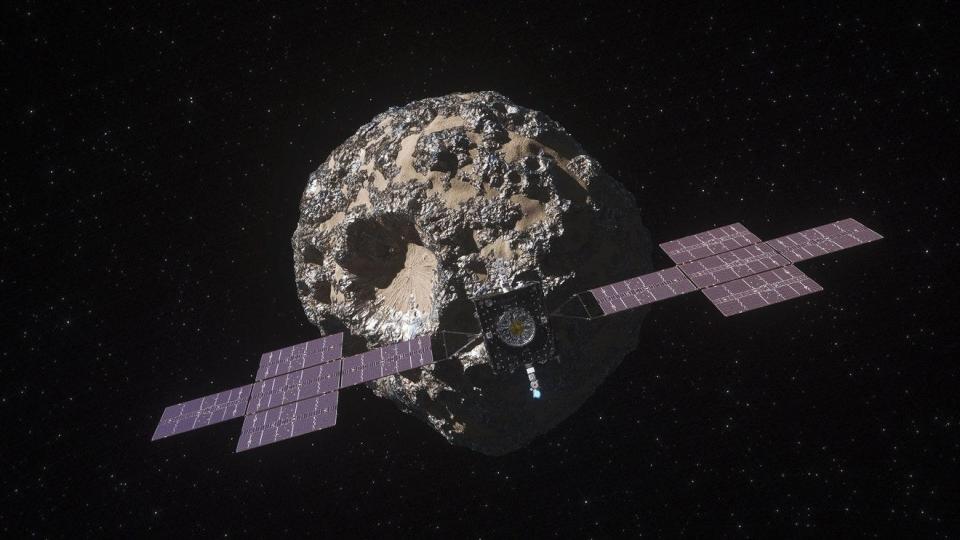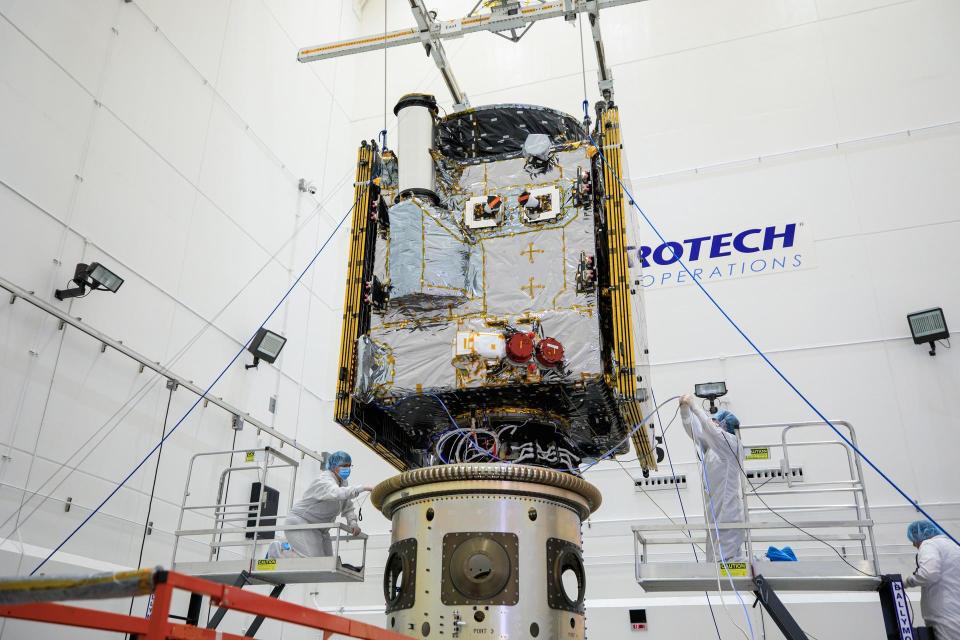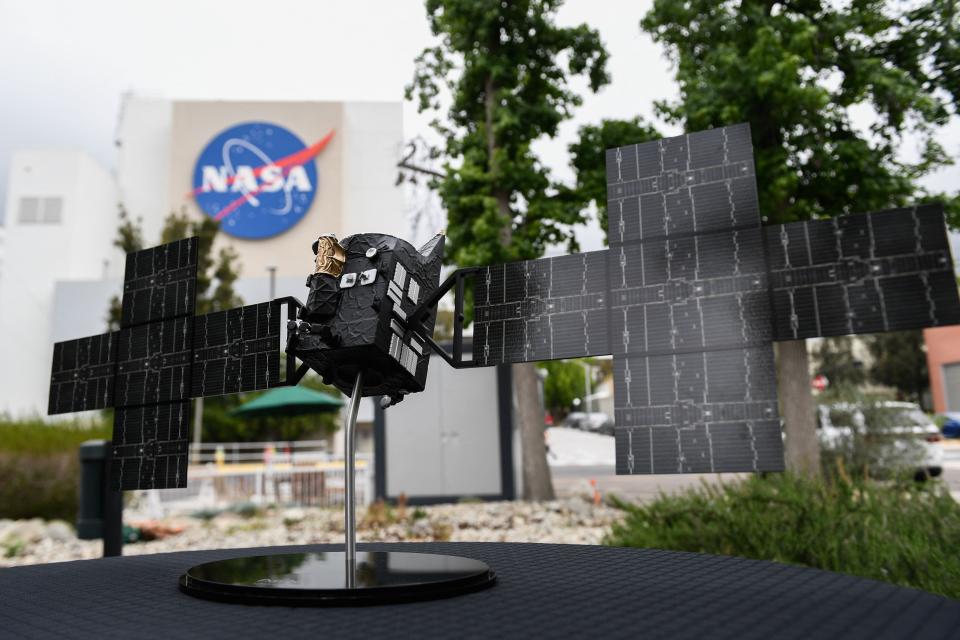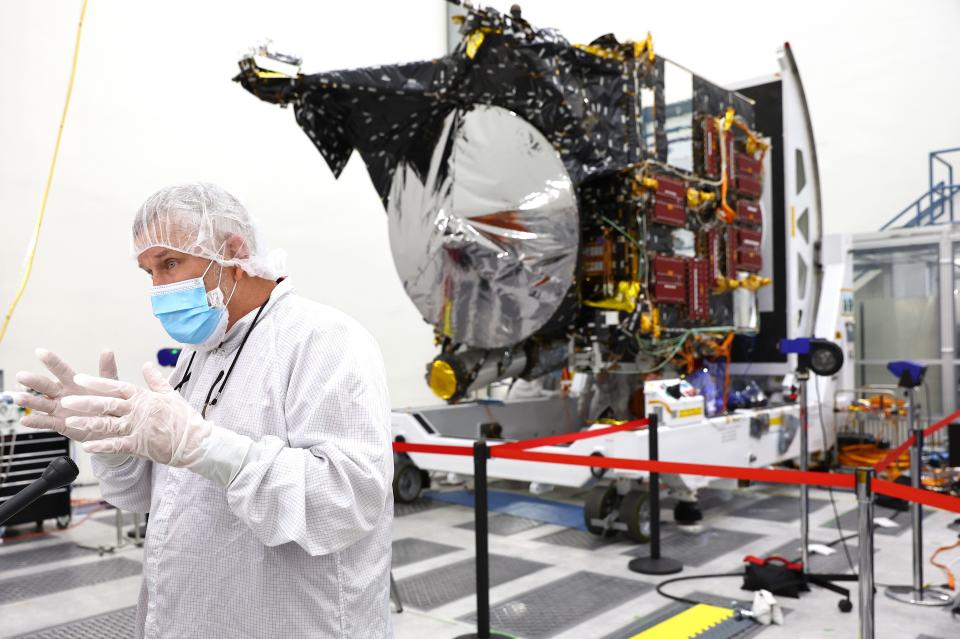What to know about the Psyche mission, NASA's long-awaited trip to a strange metal asteroid
The heart of our own planet lies frustratingly out of reach of scientists, who are instead turning their sights to the skies to learn more about what's located far below Earth's rocky mantle and crust.
For years, scientists at NASA have been preparing for the highly anticipated Psyche mission that will send off an uncrewed spacecraft on a long journey to reach a metal-rich asteroid that bears striking similarities to Earth's own core. But after a year-long delay, that long-anticipated mission is finally ready for liftoff as early as Thursday.
With an ever-shortening launch window, the Psyche spacecraft named for the asteroid to which it's bound should soon be ready to launch from NASA's Kennedy Space Center in Florida on SpaceX's triple-core Falcon Heavy rocket. Ahead of the craft is a six-year, 2.2 billion-mile expedition to the Psyche asteroid orbiting the sun between Mars and Jupiter.
Here's what to know about the Psyche mission.

Record space flight: Astronaut Frank Rubio spent a record 371 days in space. The trip was planned to be 6 months
Why do scientists care about the asteroid Psyche?
Located approximately three times farther from the Sun than Earth, Psyche is named after its 1852 discovery for the Greek goddess of the soul who was born mortal and married Eros, the god of Love.
The mysterious metallic object floating in the far reaches of the main asteroid belt between Mars and Jupiter is one scientists have long believed could harbor secrets of Earth's own core, as well as those of other terrestrial planets.
As planetary bodies take shape within star-circling rings of gas and dust, they may be smashed, broken up, vaporized or face other mayhem. Few become terrestrial planets like Earth — atmospheres intact with metallic interiors and outer crusts.
Psyche — a 140-mile wide chunk of metal and rock that may be part of the interior of a planetary building block called a planetesimal — didn't turn out that way. NASA scientists theorize that the asteroid could be a partial exposed core composed of nickel-iron, the shattered remnants of an early planet that never got a chance to form.
While rocks on Mars, Venus, and Earth are flush with iron oxides, Psyche’s surface doesn’t seem to feature much of these chemical compounds, suggesting that its history differs from standard stories of planetary formation.
Because scientists are unable to bore a path deep enough to reach Earth's metallic core, sending a spacecraft billions of miles away was the next best solution. Studying it could help scientists learn about planetary cores and how Earth and other rocky planets formed.
NASA began planning its Psyche mission in 2017 to investigate the previously unexplored metallic asteroid of the same name as part of the agency’s Discovery Program formed in 1992.
The mission — a first to an asteroid with substantial amounts of metal rather than those made mostly of rock or ice — is led by Arizona State University. NASA’s Jet Propulsion Laboratory in Pasadena, California, is responsible for the mission’s overall management, operations and navigation.

NASA UFO report: How NASA hopes to shift UAP talks 'from sensationalism to science'
What's on board the spacecraft?

With its solar arrays deployed, NASA's Psyche spacecraft would just about cover the surface of a standard tennis court.
On board are sevearl scientifc instruments to help study and analyze the metallic asteroid, including a magetometer to look for evidence of an ancient magnetic field, which would be evidence the asteroid formed from the core of a planetary body. The orbiter’s gamma-ray and neutron spectrometer will help scientists determine the chemical elements that make up the asteroid, while a multispectral imager will provide information about the mineral composition and topography of Psyche.
Attached to Psyche is the Deep Space Optical Communications, a NASA experiment that will test optical and laser communications technology beyond the moon.
From runways to rockets: Prada will help design NASA's spacesuits for Artemis mission to the moon
How long will Psyche's journey last?
The spacecraft will travel almost six years and 2.2 billion miles using a solar electric propulsion system and a gravity assist at Mars.
The spacecraft will start sending images to Earth as soon as it spots the asteroid. And when it arrives in 2029, the spacecraft will orbit and observe the asteroid for about 26 months using its store of instruments.
Why did it take so long for Psyche to launch?
The Psyche mission was initially expected to commence in August 2022 before the mission team scuttled those plans last year.
Numerous factors were part of the decision to request to delay the launch, including in-flight software problems and institutional issues.
In response, the Psyche mission added more team members, reorganized part of its workforce and adopted metrics to ensure that the launch was on track. Among the changes was an update to the Jet Propulsion Laboratory's hybrid work policy to increase the number of days team members spend together onsite each week.
Last week, NASA and SpaceX adjusted the targeted launch window of the Psyche mission from Oct. 5 to Oct. 12 to allow teams more time for spacecraft checkouts.
How can I watch the launch?

NASA will provide coverage of the upcoming prelaunch and launch activities for the mission, which is targeted for launch at 10:16 a.m. Eastern Time on Thursday.
Live launch coverage will begin at 9:15 a.m. on NASA TV, with commentary beginning after about 15 minutes.
Additionally, that broadcast coverage will stream on the space agency's YouTube channel, X account, Facebook page, Twitch, and the NASA mobile app.
Eric Lagatta covers breaking and trending news for USA TODAY. Reach him at elagatta@gannett.com
This article originally appeared on USA TODAY: NASA Psyche mission set for launch to metallic asteroid: What to know

